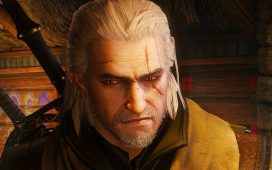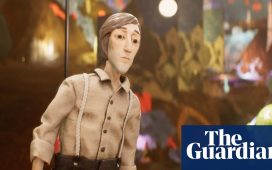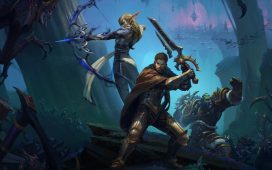nimal Crossing has been a thing for almost 20 years, but this year it has exploded. You cannot scroll through any social media feed without seeing one of its benign, big-headed characters in a screenshot or video showing off someone’s beautifully tended desert island. Celebrities including Elijah Wood have been delighting fans by turning up to visit their towns. People who’ve rarely played games before have been picking it up as a lockdown distraction – including Lauren Laverne, who enthused about it on her Radio 6 Music show. US congresswoman Alexandria Ocasio-Cortez picked it up a few days ago and has been visiting her Twitter followers.
Since the latest game, New Horizons, came out on 20 March, it has become a cliche to say that this is the game we all need right now. But if the numbers are anything to go by – it’s been setting new records, selling 11m copies by the end of March – then it’s absolutely true.
guys I tweeted my turnip prices and elijah wood just came to my island and hung out ????? this is the best day in quarantine yet pic.twitter.com/H3mYJWnvgR
— jessa ? (@directedbyrian) April 23, 2020
For those untouched by the cult of Nook, Animal Crossing: New Horizons lets you set up an alternate life on a pleasant island populated by gently weird animals. You fish, catch bugs, water flowers, plant fruit trees and accumulate cute things with which to decorate your home and set dress the island. Players have put together everything from haunted houses to zen gardens to little farmers’ markets and libraries. It is a relaxing game with a chill vibe – in theory.
In reality, plenty of players are breaking it apart at the seams, turning their islands into aerial portraits of Sailor Moon, getting deep into hybrid flower agriculture theory, or plugging into shady networks of turnip-traders to amass 1%-er level riches on the game’s “stalk market”. (Yes, that is a thing.) But this is part of Animal Crossing’s magic: you really can play it the way you like. It can occupy you for a few hours a week, pootling around pulling up weeds and catching up with your penguin neighbour; or for hours every day, amassing wealth and furniture and clothing until your virtual house looks like an imaginative 12-year-old’s dream mansion.
In Kyoto, Japan, the game’s creators at Nintendo are finding the immense virality of Animal Crossing: New Horizons validating, because this is a game designed to be shared.

“Animal Crossing is a communication game,” says Aya Kyogoku, who has worked on every Animal Crossing game since 2003. “I hope that through their life in the game world, people enjoy communicating with each other, whether it’s through playing with other people or talking enthusiastically about the game. What would make me most happy is if people with all kinds of different tastes come together and enjoy the game in their own ways.”
Hisashi Nogami, Animal Crossing series producer, who has been at Nintendo since 1994, says: “If, when you’re playing, you’re thinking about some day showing somebody what you’ve achieved, or telling them about it, then maybe you’ll feel differently. We are continually asking ourselves about what kind of place the game could have in people’s actual lives.”
This is an important thing to understand: the game is played in social groups. I have four Animal Crossing group chats, with participants ranging from mums and dads playing with their kids to game-developer acquaintances to furloughed friends, all of them continually trading DIY tips, sought-after furniture and screenshots. We visit each others’ islands to share fruits and admire island decor, or hang out on the beach to wish on shooting stars and chat.
Animal Crossing is absorbing because it conjures the effect of a living world, one that continues whether or not you are there. Time passes as it does in real life, with changing weather and seasons; animal neighbours chat to you and write letters as if they’ve got minds of their own; and everything on the island feels interconnected.
This illusion is hard to achieve, says Nogami, and introducing new Bells and whistles can throw off the balance. “We put a lot of thought and feeling into even the smallest features,” he says. “Rather than looking at whether individual ideas are good or bad, we first think about the overall experience we want players to have, deciding on the concept that will form the pillar of the game. Everything we build must align with that concept. For this game, the concept was the deserted island.”
“It’s very hard,” says Kyogoku, “to make decisions about individual parts before all of the features are connected, and that’s a process we wrestled with again on this game. Even when we are coming up with ideas, we aren’t thinking about that feature by itself. We think about where this feature would be positioned within Animal Crossing as a whole.”
Kyogoku uses New Horizon’s DIY crafting as an example – “it isn’t simply about making items; you also need resources, and you can harvest these resources from trees and other things on the island. So, by having this feature, the plants that existed before in the series now gain a new purpose, and the feature was included partly because of this new value it brings.”

Animal Crossing has always been popular, especially in Japan; launched in 2012, New Horizons’ predecessor, New Leaf, sold more than 12m. But there’s no doubt that it’s attracting a huge number of new players. Part of that is surely down to the coronavirus pandemic. Stuck at home, millions of people are turning to video games for fun and safe social interaction, and a game that offers the comfort of a carefree existence in nature has proved especially appealing. Suddenly, Animal Crossing veterans find themselves with valuable knowledge and are delighted to share it.
“Animal Crossing is a game that experienced players and newcomers alike can enjoy,” says Nogami. “It’s also fine to join in later, after launch. People who have been playing longer will have more knowledge and tips about living in the Animal Crossing world, and by sharing this information with others they may be able to enjoy their life on the island even more.”
A number of subtle changes to New Horizons make it more welcoming than older Animal Crossing games. It gives new players more direction in the early days and weeks, guiding them towards self-directed fun and self-expression. It is also a game whose time has finally come. Social media, connectivity, even the way we now use smartphones have helped it to burst through into popular culture.
“When Animal Crossing emerged 19 years ago,” says Nogami, “it was difficult to explain what it was within the framework of games up to that point. Although I believed it was fun, I was unsure whether many users would understand it. [But] I felt that the parts that were difficult to understand brought a uniqueness to the game and may be why the games have been loved by fans for so long.
“We’ve added all kinds of features appropriate for the modern era, and made improvements to make the games more convenient, but the core hasn’t changed. One of our goals with these games is to connect people. People who played the N64 version as a child probably now have families of their own. I hope people will play with family and friends, having fun across generations.”













